
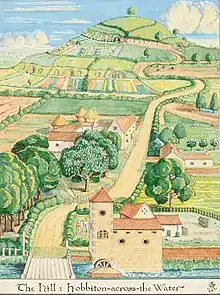
Bag End is the underground dwelling of the Hobbits Bilbo and Frodo Baggins in J. R. R. Tolkien's fantasy novels The Hobbit and The Lord of the Rings. From there, both Bilbo and Frodo set out on their adventures, and both return there, for a while. As such, Bag End represents the familiar, safe, comfortable place which is the antithesis of the dangerous places that they visit.[3] It forms one end of the main story arcs in the novels, and since the Hobbits return there, it also forms an end point in the story circle in each case.[4]
Tolkien described himself as a Hobbit in all but size. Scholars have noted that Bag End is a vision of Tolkien's ideal home, and effectively an expression of character.[3] Peter Jackson built an elaborate Hobbiton film set including a detailed Bag End in New Zealand for his The Lord of the Rings film series.
Description
J. R. R. Tolkien
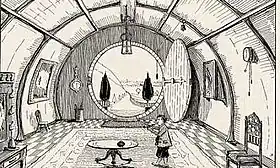
The Hobbit begins with "among the most famous first lines in literature":[5]
In a hole in the ground there lived a hobbit. Not a nasty, dirty, wet hole, filled with the ends of worms and an oozy smell, nor yet a dry, bare, sandy hole with nothing in it to sit down on or to eat: it was a hobbit-hole, and that means comfort.[6]
The protagonists of The Hobbit and The Lord of the Rings, Bilbo and Frodo Baggins, lived at Bag End, a luxurious smial or Hobbit-burrow, dug into The Hill on the north side of the town of Hobbiton in the Shire's Westfarthing. Tolkien made drawings of Bag End and Hobbiton. His watercolour The Hill: Hobbiton-across-the Water shows the exterior and the surrounding countryside.[2] Tolkien made several pencil and ink sketches for these subjects, only gradually settling on Bag End's final location and architecture.[7][8]
Another of Tolkien's drawings, The Hall at Bag-End, Residence of B. Baggins Esquire, depicts the interior, complete with 20th century fittings such as a wall clock and barometer. Another clock is mentioned in chapter 2 of The Hobbit.[9] The barometer is mentioned in Tolkien's drafts of The Hobbit.[10]
Peter Jackson
.jpg.webp)
Peter Jackson had an elaborate Hobbiton film set built on the Alexander sheep farm at Matamata in New Zealand for his The Lord of the Rings film series. It included a water-mill, the Green Dragon Inn, and several Hobbit-holes as well as Bag End in a small hill, with garden.[11] Jackson said of the set, "It felt as if you could open the circular green door of Bag End and find Bilbo Baggins inside."[12]
Chad Chisholm and colleagues, reviewing Jackson's 2012 film The Hobbit: An Unexpected Journey for Mallorn, write that Jackson humorously has the "rough and ready" Dwarves "bursting into Bilbo's neat little home and cleaning out his pantry", providing "a sort of constant comic relief to the dangers in the dark".[13]
Analysis
Real-world origins
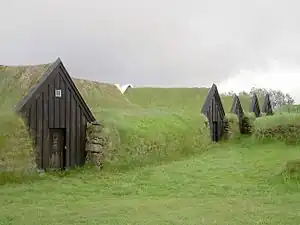
"Bag End" was the real name of the Tudor home, dated to 1413, of Tolkien's aunt Jane Neave in the village of Dormston, Worcestershire.[14][15] The scholar of literature and film Steven Woodward and the architectural historian Kostis Kourelis suggest that Tolkien may have based his Hobbit-holes on Iceland's turf houses, such as those at Keldur.[16]
Character from architecture
Tolkien stated "I am in fact a Hobbit", and scholars agree that he was in many ways like his Hobbits, enjoying good food, gardening, smoking a pipe, and living in a familiar and comfortable home.[5] Tolkien makes Bag End a place where, in the Tolkien scholar Thomas Honegger's words, "most readers feel severely tempted to put on their imaginary slippers and settle down to a piece of cake and some tea."[3] Honegger argues that places have a critical role in The Lord of the Rings, and the function of the safe Hobbit-hole is to establish the character of the "hol-bytlan (hole-dwellers), in the first place stationary beings who have a deep-rooted aversion against travelling outside the Shire." For them, Honegger writes, "Travelling abroad belongs to the same class as adventures", quoting Bilbo's remark in The Hobbit: "Nasty disturbing uncomfortable things! Make you late for dinner!"[3]
Joseph Wright's 1898–1905 The English Dialect Dictionary has an entry for hobman, one of many possible sources of the word hobbit, which states that "Each elf-man or hobman had his habitation, to which he gave his name".[17] The Tolkien scholar Michael Livingston comments that from this it is easy "to recall the man-like, elf-friend, hole-dwelling hobbit Mr. Baggins of Bag-End, hired by the not-too-dissimilar dwarves to commit thievery".[17]
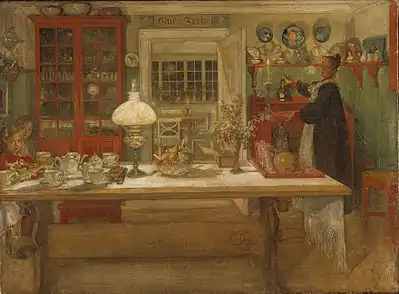
The scholar of literature Johanna Brooke writes in the Journal of Tolkien Research that the character of Bilbo Baggins can be inferred from the architecture of Bag End, just as that of Hobbits in general can be deduced from their preference for living in holes. She suggests that Bag End is an Arts and Crafts building, fitting into the ideas of the designer William Morris and others in the period between 1880 and 1920. Features such as Bag End's panelled walls, tiles, and carpet could all, Brooke writes, have been manufactured by Morris & Co., while the prosperous Hobbit-hole clearly indicates that Bilbo is middle-class. Its position at the top of The Hill "demonstrates a physical and social elevation above other hole-owners",[2] since as Tolkien wrote in the Prologue to The Lord of the Rings, "suitable sites for these large and ramifying tunnels...were not everywhere to be found".[2]
Brooke notes Tolkien's statement that "only the richest and poorest"[2] in fact were able to continue the traditional Hobbit-practice of living in holes: the poor might have, as Tolkien said, "burrows of the most primitive kind... with only one window or none".[2] Bag End is sharply contrasted with such a burrow, its best rooms being provided with "deep-set round windows". Brooke comments that Tolkien has shown this in The Hill: Hobbiton-across-the-Water, where Bag End has several windows while the Hobbit-holes further down (of Bagshot Row) have fewer. Other signifiers of wealth and class include such Victorian era comforts as a dining-room, multiple pantries, and wardrobes. Such things could indicate, Brooke writes, that Bag End's owner is "indulgent, overly-luxurious, too comfortable, a tad vain even",[2] though against this, the hanging-space for many hats and coats suggests that welcoming guests is important to him. Brooke quotes Morris's remark that "the working man cannot afford to live in anything that an architect could design; moderate-sized rabbit-warrens [are] for rich middle-class men",[18] stating that with its mention of rabbit warrens, this "aptly suits Bag End".[2]
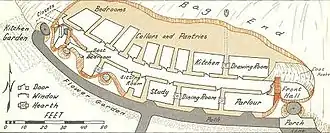
The cartographer Karen Wynn Fonstad created a plan of Bag End, showing her vision of its comfortable layout with many cellars and pantries, complete with multiple fireplaces and chimneys, based on the clues given by Tolkien in The Hobbit and The Lord of the Rings. Her plan makes Bag End some 130 feet (40 m) long and up to 50 feet (15 m) wide, cut into the Hill.[19] Honegger writes that Fonstad's work has contributed substantially to giving Middle-earth an "independent existence".[3]
Only one outlet
The Tolkien scholar Tom Shippey writes that the name Bag End is a direct translation of the French cul-de-sac ("bottom of [a] bag"), something that he calls "a silly phrase... a piece of 'French-oriented snobbery', used in England to mean a dead end, a road with only one outlet"; he notes that the French say impasse for the same thing.[lower-alpha 1][20][21] The journeys of Bilbo and Frodo have been interpreted as just such confined roads, as they both start and end in Bag End. According to Don D. Elgin, Tolkien's A Walking Song, which appears repeatedly in differing forms in The Lord of the Rings as the quest progresses, is "a song about the roads that go ever on until they return to at last to the familiar things they have always known."[4] As such, it forms one end of the main story arcs in both The Hobbit and The Lord of the Rings, and since the Hobbits return there, it also forms an end point in the story circle in each case.[4]
The most desirable residence

The journalist Matthew Dennison compares Lobelia Sackville-Baggins's desire to move into Bag End to the similarly-named aristocrat Vita Sackville-West's passionate attachment to her family home, Knole House, which she was unable to inherit. Sackville-West became famous as a novelist and poet, and by the time The Lord of the Rings was published, as The Observer's gardening columnist. Dennison notes that Lobelia is a garden flower, and that readers in the 1950s would immediately have linked the character to the famous gardener.[22]
Shippey argues that the Bagginses and the Sackville-Bagginses are "connected opposites", since the opposite of a bourgeois is a burglar, a person who breaks into bourgeois houses, and in The Hobbit Bilbo is asked to become a burglar, to break into the lair of Smaug the dragon.[20] He observes that the name Sackville-Baggins, for the snobbish branch of the Baggins family,[23] is a philological joke, as Sac[k]-ville can be translated as the French form of the humble "Bag Town", another attempt to reinforce the family's bourgeois status by "Frenchify[ing]" their surname.[20]
| Feature | Bilbo Baggins | Lobelia Sackville-Baggins |
|---|---|---|
| Manner, attitude | Plain | Snobbish |
| Role in story | Burglar | Bourgeois |
| Language | English (dialect)[lower-alpha 2] | Frenchified |
| No through road | Bag End | cul-de-sac |
| Bag End | Actual owner, resident | Would-be owner, resident |
Contrasts with faraway places

The historian Joseph Loconte wrote that Tolkien had set up a contrast between Frodo's light and serene Bag End and the corrupted wizard Saruman's dark and industrially destructive Isengard. Loconte likens this to the contrast in Tolkien's fellow-Inkling C. S. Lewis's 1950 children's book The Lion, the Witch and the Wardrobe between the delightful but humble home of Mr. and Mrs. Beaver, and the icy opulence of the palace of the White Witch. In Loconte's view, both authors "reintroduce[d] into the popular imagination a Christian vision of hope in a world tortured by doubt and disillusionment".[25][26]
Honegger points out a quite different contrast, between Bag End as depicted in Tolkien's drawing The Hall at Bag End, "the homely yet narrowly limited space of a hobbit-hole with the similarly neat and defined landscape of the Shire in the background," with his The Forest of Lothlórien in Spring, which shows "no particular place, but an airy glade in a forest filled with sunlight, evoking a feeling of sheltered openness."[3] If the Shire is a "secluded [and] remote petit bourgeois idyll", then, Honegger suggests, Lothlórien is a "transcendental [or] idealised idyll". Further, the comfortable Hobbit-holes of the Shire stand in contrast to the untamed nature of the Old Forest, the idyllic Rivendell, and even to what had been the "promised land" of the Dwarves, Moria. The same applies, Honegger argues, to time: where Bag End and the Shire are anachronistically in the present, the Old Forest, Rivendell, and Lothlórien represent journeys back into the past.[3]
| Bag End, The Shire | Faraway place | |||
|---|---|---|---|---|
| Quality | Time | Name | Quality | Time |
| Homely, narrowly limited | In the present | Forest of Lothlórien |
Sheltered openness | In the past |
| Secluded petit bourgeois idyll | transcendental, idealised idyll | |||
| Comfortable, tame | Old Forest | Untamed nature | ||
| Rivendell | Idyllic | |||
| Moria | Dwarves' promised land | |||
Strangeness
Bag End receives strange visitors – Gandalf and the Dwarves, making it seem a "queer place", in the character Ted Sandyman's words, "and its folk are queerer". Bilbo and Frodo come to be seen as strange also. Bilbo is "very rich and very peculiar", not least because he seems not to grow old, but also because he went on a journey outside the Shire, and returned changed.[27][28] David LaFontaine writes in The Gay and Lesbian Review Worldwide that Bilbo is a "confirmed bachelor" who is never "linked romantically" with any woman, and who lives alone in the "luxurious, lovely environment", Bag End, "illustrating the hobbit's artistic sensibility".[29] LaFontaine comments that Tolkien admires Bilbo's "unconventional lifestyle ... almost to the point of envy." To LaFontaine, Tolkien's account of Bilbo's "queerness" is to be interpreted as a portrait of a homosexual man.[29]
Parody
The 1969 parody novel Bored of the Rings, written by the National Lampoon founders Henry Beard and Douglas Kenney, mocks Frodo's homecoming from his dangerous quest to Bag End with the words "he walked directly to his cozy fire and slumped in the chair. He began to muse upon the years of delicious boredom that lay ahead. Perhaps he would take up Scrabble".[30]
Notes
- ↑ The French actually also say un cul-de-sac, see the relevant French Wiktionary entry.
- ↑ Shippey notes that "Baggins" is close to the spoken words bæggin, bægginz in the dialect of Huddersfield, Yorkshire.[24][23]
References
- ↑ Holmes, John R. (2013) [2007]. "Art and Illustrations by Tolkien". In Drout, Michael D. C. (ed.). J.R.R. Tolkien Encyclopedia. Routledge. pp. 27–32. ISBN 978-0-415-86511-1.
- 1 2 3 4 5 6 7 8 9 Brooke, Johanna H. (2017). "Building Middle-earth: an Exploration into the uses of Architecture in the works of J. R. R. Tolkien". Journal of Tolkien Research. 4 (1). Article 1.
- 1 2 3 4 5 6 7 8 9 Honegger, Thomas (2004). "From Bag End to Lórien: the Creation of a Literary World". In Peter Buchs; Thomas Honegger (eds.). News from the Shire and Beyond – Studies on Tolkien (2nd ed.). Zurich and Berne: Walking Tree Publishers. pp. 59–81. ISBN 978-3-9521424-5-5.
- 1 2 3 Croft, Janet Brennan, ed. (2007). "What's at the Bottom of The Lord of the Rings and A Midsummer Night's Dream?". Tolkien and Shakespeare: Essays on Shared Themes and Language. McFarland & Company. pp. 52–53. ISBN 978-0-786428274. Citing: Elgin, Don D. (1985). The Comedy of the Fantastic: Ecological Perspectives on the Fantasy Novel. Greenwood Press. ISBN 9780313232831.
- 1 2 Vollrodt, Kim (20 September 2017). "Tolkien trivia: "In a hole in the ground there lived a hobbit"". Oxford University Press. Retrieved 20 August 2022.
- ↑ Tolkien 1937, Chapter 1. An Unexpected Party.
- ↑ Hammond, Wayne G.; Scull, Christina, eds. (1995). J. R. R. Tolkien: Artist & Illustrator. HarperCollins. pp. 96–107. ISBN 978-0-261-10322-1.
- ↑ McIlwaine, Catherine (2018). Tolkien: Maker of Middle-earth. Bodleian Library. pp. 295–298. ISBN 978-1-851-24485-0.
- ↑ Tolkien 1937, Chapter 2. Roast Mutton."If you had dusted the mantelpiece you would have found this just under the clock,' said Gandalf, handing Bilbo a note" [from Thorin]..
- ↑ Tolkien, J. R. R. Bilbo's last Song: (for "XIV. Return to Hobbiton" note 21) "the Hornblower who received the barometer now changes from Cosimo (by way of Carambo) to Colombo." (A Long-expected Party): "For Cosimo Chubb, treat it as your own, Bingo: on the barometer. Cosimo used to bang it with a large fat finger whenever he came to call. He was afraid of getting wet, and wore a scarf and macintosh all the year round."
- ↑ Huffstutter, P. J. (24 October 2003). "Not Just a Tolkien Amount". Los Angeles Times.
- ↑ Brodie, Ian (2004). The Lord of the Rings Location Guidebook (Extended version ed.). Auckland: HarperCollins. p. 19. ISBN 978-1869505301.
- ↑ Chisholm, Chad (2013). "Review: A journey to the cinema. Reviewed Work: 'The Hobbit: An Unexpected Journey' by Peter Jackson". Mallorn (54 (Spring 2013)): 14–26. JSTOR 48614797.
- ↑ "Lord of the Rings inspiration in the archives". Explore the Past (Worcestershire Historic Environment Record). 29 May 2013.
- ↑ Morton, Andrew (2009). Tolkien's Bag End. Studley, Warwickshire: Brewin Books. ISBN 978-1-85858-455-3. OCLC 551485018. Andrew Morton wrote an account of his findings for the Tolkien Library.
- ↑ Woodward, Steven; Kourelis, Kostis (2006). "Urban Legend: Architecture in The Lord of the Rings". In Mathijs, Ernest; Pomerance, Murray (eds.). From Hobbits to Hollywood: Essays on Peter Jackson's 'Lord of the Rings'. Brill. pp. 189–214. doi:10.1163/9789401201513_016. ISBN 978-90-420-1682-8. S2CID 243929250.
- 1 2 Livingston, Michael (2012). "The Myths of the Author: Tolkien and the Medieval Origins of the Word "Hobbit"". Mythlore. 30 (3/4): 129–146. JSTOR 26815505.
- ↑ Morris, William (2008) [1888]. "The Revival of Architecture". In Harry Francis Mallgrave; Christina Contandriopoulos (eds.). Architectural Theory Volume II: an Anthology from 1871 to 2005. Singapore: Blackwell Publishing. p. 15.
- 1 2 Fonstad, Karen Wynn (1994) [1981]. The Atlas of Middle-earth. HarperCollins. pp. 118–119.
- 1 2 3 4 Shippey, Tom (2001). J. R. R. Tolkien: Author of the Century. HarperCollins. pp. 5–11. ISBN 978-0261-10401-3.
- ↑ "cul-de-sac". Collins English-French Dictionary. Retrieved 20 April 2020.
- 1 2 Dennison, Matthew (18 August 2015). "Behind The Mask: Vita Sackville-West". St. Martin's Press. Archived from the original on 20 September 2015. Retrieved 20 April 2020.
- 1 2 3 Shippey, Tom (1982). The Road to Middle Earth. Allen & Unwin. p. 66. ISBN 978-0-547-52441-2.
- ↑ Shippey cites Haigh, W. E. (1928). Glossary of the Dialect of the Huddersfield District. Oxford University Press., noting that Tolkien had written the Prologue.
- ↑ Loconte, Joe (2015). A hobbit, a wardrobe, and a great war : how J.R.R. Tolkien and C.S. Lewis rediscovered faith, friendship, and heroism in the cataclysm of 1914–1918. Nashville, Tennessee. pp. xiv–xv. ISBN 978-0-7180-2176-4. OCLC 910568768.
{{cite book}}: CS1 maint: location missing publisher (link) - ↑ Tirrell, Jeffrey (March 2018). "Review: A Hobbit, a Wardrobe, and a Great War: How J. R. R. Tolkien and C. S. Lewis Rediscovered Faith, Friendship, and Heroism, in the Cataclysm of 1914–1918 by Joseph Loconte". Anglican and Episcopal History. 87 (1): 116–118. JSTOR 44783383.
- ↑ Chance, Jane (1995). "Power and Knowledge in Tolkien: The Problem of Difference in "The Birthday Party"". Mallorn: The Journal of the Tolkien Society (33, Proceedings of the J.R.R. Tolkien Centenary Conference: Keble College, Oxford, 1992): 115–120. JSTOR 45320421.
- ↑ Craig, David M. (January 2001). "Queer lodgings": gender and sexuality in "The Lord of the Rings". Mallorn (38): 11–18. JSTOR 45321703.
- 1 2 LaFontaine, David (2016). "The Tolkien in Bilbo Baggins". The Gay & Lesbian Review Worldwide. 23 (6).
- ↑ Beard, Henry; Kenney, Douglas (1969). "10 Be it Ever so Horrid". Bored of the Rings: a Parody of J.R.R. Tolkien's The lord of the Rings. New York: Signet (New American Library). ISBN 978-0-451-13730-2.
Sources
- Tolkien, J. R. R. (1937). The Hobbit. George Allen & Unwin.
